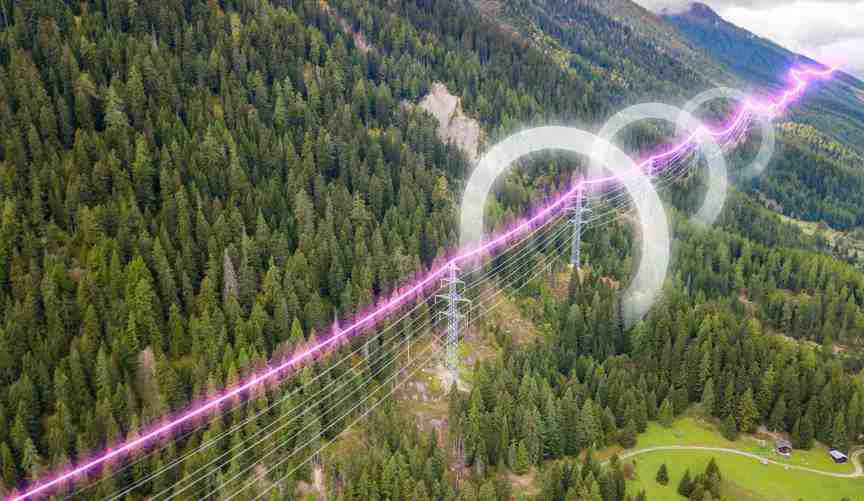(Photo: This artist’s rendering shows how Prisma Photonics uses fiber-optic lines strung along transmission towers (highlighted in pink) to detect temperature, pressure, and electromagnetic disturbances in the nearby environment (the white circles). Credit: Prisma Photonics)
Lots of costly and dangerous things can go wrong with high-voltage transmission lines.
Strong winds or equipment failures can cause individual lines on a tower to contact one another and short-circuit, or even break entirely. Lines can sag hazardously near trees or the ground, either due to overheating or being caked in ice. They can be damaged by wildfire smoke, windblown debris, or the simple wear and tear of time.
Sensors can help detect such threats. But it’s expensive and time-consuming to install, connect, and maintain those devices along power lines crossing remote plains, forests, and mountains.
It would be a lot cheaper and faster for utilities if they could simply use existing infrastructure to detect these issues instead of tacking on new sensors. That’s the route that Prisma Photonics has taken.
The Israel-based company has plugged its technology into the fiber-optic communications cables strung alongside thousands of miles of transmission lines in Israel, Europe, and the U.S.
That technology has been able to identify the precise locations of problems causing power outages, including ice buildup on power lines and nearby wildfires, all by “using the fiber as a microphone, or as an array of thousands of small microphones,” Eran Inbar, Prisma Photonics’ CEO, explained. The firm’s product has even picked up on the explosion of a meteor in the Earth’s upper atmosphere.
For decades, utilities have strung “optical ground wire” fiber-optic cables atop transmission towers, both to protect high-voltage wires from lightning strikes and to provide telecommunications for internal or third-party use. Across the world and the U.S., more than half of the transmission system is outfitted with these cables, Inbar said — and that coverage is only growing as more power lines are built.
That opens up a huge market for Prisma Photonics, as long as it can prove its technology is accurate enough to replace purpose-built sensors for a growing number of tasks. The more jobs Prisma’s technology can do, the more money it could potentially save transmission grid operators, Inbar said.
Finding ways to do more things with less money and less time is important for transmission owners striving to solve multiple challenges at once. Climate change-driven heat waves and winter freezes are causing more grid emergencies, both by increasing demand for electricity for air conditioning and heating and by subjecting transmission networks to increased stress.
“The grid is a very important market — but it was also a blue ocean. There were no other companies playing in this field,” said Inbar, a physicist by training who spent 20 years in the field of lasers for semiconductor and mobile technology markets before selling his company in 2014 and launching Prisma Photonics in 2017. “Can we detect short circuits? Can we detect partial discharge? Can we detect wildfire? Can we detect wind for dynamic line rating?”
Prisma’s “optical interrogator” devices plug into substations, where multiple transmission lines and the fiber-optic cables that run atop them converge. From these central points, its devices send pulses of light down an optical fiber, then capture and analyze infinitesimal reflections cast back from points along the fiber.
This is one of several methods to use fiber-optics as sensors to detect shifts in temperature, pressure, strain on the cables, and other signals, Inbar said. “It’s a very small change — but if you’re using a precise optical method, you can measure it.”
Connecting these nearly imperceptible variations to changes in the surrounding environment takes a ton of data, some complicated machine-learning algorithms to convert it into usable information, and a lot of real-world cross-checking, he said. One of Prisma’s first tasks was to eliminate the false positives — alerts of events that didn’t actually happen — that have stymied earlier efforts to use already-deployed fiber-optic cables to sense environmental conditions.
“You have to be highly committed to data collection,” he said. “There’s no way to do it in the lab — you have to go to the grid and collect data over months or, in our case, years.”
But the more Prisma’s systems are used in the real world, the more confident customers can be in correlating their measurements with real-world events. After a yearslong deployment with Prisma investor Israel Electric Corp. and other pilot projects with the New York Power Authority and as-yet-unnamed European grid operators, “we don’t have to do months and years of data collection” when deploying with its next utility partners, Inbar said. “We can go to work immediately.”
That’s the goal of Prisma’s latest project with Great River Energy, a rural electric cooperative operating transmission lines across Minnesota and Wisconsin. The initial project is targeting about 90 miles of power lines, all being monitored from computers operating inside substations.
“There is a huge impetus for reliability on the electric system,” said Michael Craig, Great River Energy’s manager of energy management systems. At the same time, “every time we’re looking to spend money, we have to justify that it’s going to be worth it to everybody in our membership. With Prisma, there were a couple of things that made it easier for us.”
“First, it’s using existing assets,” he said, referring to the fiber-optic cables already deployed on the 90 miles of line the co-op is monitoring. “We didn’t have to do this big buildout. It’s just going into the substation and doing the work” to connect Prisma’s equipment to the fiber-optic system.

A Prisma Photonics employee installs equipment in a substation operated by Minnesota electric cooperative Great River Energy. (Prisma Photonics)
Second, Prisma’s technology could offer a lower-cost way to deal with grid faults, Craig said. A bewildering array of technologies and techniques go into determining just where and how power flows have been interrupted along high-voltage power lines. Generally speaking, more precise approaches require more costly technologies, including sensors installed on transmission lines themselves.
Being able to tap into the continuous sensor of a fiber-optic line could help. “If there is an outage, maybe we’ll be able to detect what happened before we get out there,” he said. “Hopefully we can detect things more quickly. We hope it can allow us to be preventative, rather than reactive.”
Third, Prisma’s technology can potentially do many things at once, Craig said. One option is to use it for “dynamic line rating” — determining how much power transmission lines are able to safely carry under different temperatures and wind speeds, a process which can expand the capacity of existing grids without costly upgrades. Great River Energy is already testing dynamic line rating sensors installed on power lines but is eager to explore other approaches, he said.
At the same time, Craig said, Great River Energy is exploring the use of cameras in remote areas to detect wildfires — another pressing concern for power grid operators. With Prisma, “instead of installing cameras and having this one system, we can use the existing fiber as a sensor. That’s a cool way to do it.”
Inbar stressed that Prisma Photonics is still in the process of gaining real-world experience to prove how useful it can be for different tasks. Utilities must wait for bad things like faults or wildfires to happen to be able to check the technology’s accuracy, for example. Inbar added that Prisma plans to evaluate its dynamic line rating capabilities through tests hosted by the Electric Power Research Institute, a nonprofit power-sector research group considered the gold standard for utilities.
Whatever the use case, “one of the benefits of our solution is that it’s a platform,” he said. “It’s not like we’re developing a sensor for dynamic line rating or wildfire detection. It’s a platform that can collect very sensitive data on the grid, and eventually we can improve it over time — and build additional use cases.”











